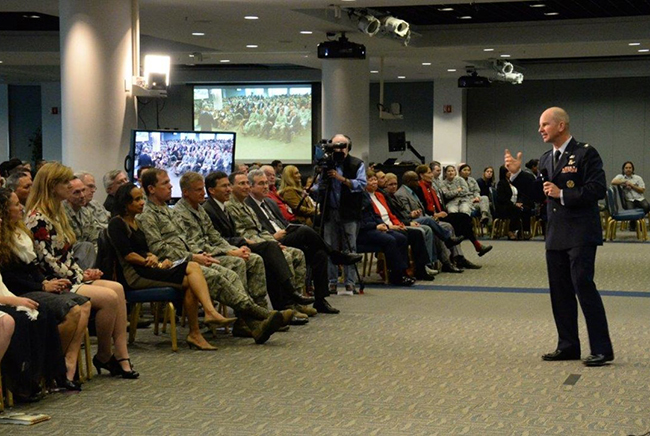
Col. Dennis Bythewood addresses an audience of family members and Space and Missile Systems Center personnel after assuming command of the Remote Sensing Systems Directorate on Dec. 19, 2016, during a change of leadership ceremony at Los Angeles AFB in El Segundo, Calif. Air Force photo by Van De Ha.
A new data repository, and the overarching strategy behind it, will shape the way the Air Force’s space and ground systems share information, Col. Dennis Bythewood, space development program executive officer at the Air Force Space and Missile Systems Center, said at an Aug. 9 AFA Mitchell Institute for Aerospace Studies event.
Air Force Space Command rolled out its new enterprise data strategy at the end of July after hiring a chief data officer nearly one year ago. That official, Mark Brady, visited more than 200 people across 82 units at 19 sites to learn about what’s not working in military space operations and how AFSPC can use data better.
“A common theme emerged—historically, data has been stored, by the military and industry, in proprietary stovepiped systems,” AFSPC said in an Aug. 6 release. “These systems are cut off from each other. They are not tied to a larger, enterprise-level architecture and they are designed to only perform specific functions or support single mission areas.”
To solve that problem, AFSPC created a cloud-based “unified data library” that cuts down on manual planning and analysis and is expected to offer courses of action to officials in near real-time.
The UDL allows an entity that puts data in to dictate who should be allowed to see each individual piece of information, in contrast with other Air Force repositories that are only available to certain people, Air Force Magazine reported in May. The library also works with the Enterprise Space Battle Management Command and Control system development effort underway at the Air Force Space and Missile Systems Center.
The Air Force is figuring out how to crunch a growing amount of information, as its space enterprise envisions a coming explosion of military and commercial systems that will collect more data.
Bythewood said the commercial satellite industry offers a “production line” mindset that can pump out new products, instead of relying on slower, hands-on labor to build exquisite satellites. He expects that approach will have ripple effects across larger, legacy satellite providers as well, but noted the same changes aren’t yet happening for space-based sensors.
The Defense Advanced Research Projects Agency’s secretive Blackjack program provides a chance to look at ways to standardize production for large quantities of sensors that can become part of broad military networks spread across the heavens, Bythewood said. Standardization can drive down costs and speed the time it takes to put technology on orbit.